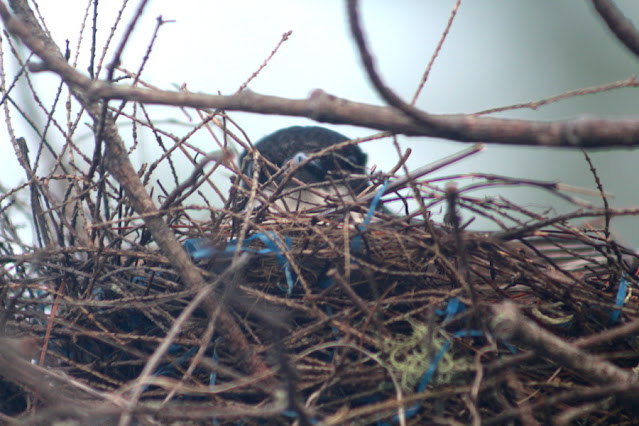It's late July and the world has become lush and green with an abundance of rain. It's interesting to watch the transition of wildflowers over the summer growing season as each species finds a place in the ecosystem to make its stand. Early in the spring before larger plants have grown leaves the small plants living right at ground level take advantage of the short window when they receive nature's life-giving energy through bare branches above. That's when plants like goldthread, trailing arbutus, and trillium do their thing. As spring moves towards summer the taller plants such as hawkweed and daiseys rise up higher to find the sun, robbing it from the lower tier of plants. Now in late July it's time for the tallest flowers, which have jostled they way up all year, to rise above the middle-tier and display their colors.
 |
| Common mullein (Verbascum thapsus) |
This mullien was growing along the multi-use trail in the Page Pond Community Forest in Meredith. Not recognizing this plant I had to look it up and found that it is yet another invasive species. This one is not as fiendish as the worst invasives such as knotweed and bittersweet because it's shade intolerant - it will die off as other plants grow around it. But it can be a problem if it grows to large populations as it will readily do if left unchecked - note huge number of seed-producing blossoms.
There were already a few of these along that trail; I've recommended the land stewards remove them. If you're at Page Pond this week be sure to explore the field at the Barnard Ridge Road trailhead which is now packed with mid-summer wildflowers attracting a potpourri of birds and insects because it will be mowed soon now that the birds have nested and fledged their young.
Many of the taller summer flowers don't have the showy blossoms of the early plants, perhaps because with the abundance of pollinators at this point in the season they don't have to advertise as much to attract customers. Overall, yellow seems to be the predominant color of the season, and this will continue into late fall as the goldenrod bloom high and tall above all else in the field until frost strikes them down. But there are other colors to be found including this aquatic plant that doesn't need rain so it always blooms - unless the geese eat all its leaves first.
 |
| Pickerel weed (Pontederia cordata) gets pollinated. |
Two plants with pale pink flowers also grow along the shores of the lakes, though their feet are planted on dry land right at the brink of water and earth.
 |
| Meadowsweet (Spiraea latifolia) - look for the tiny honey bee at the bottom of the tallest blossom. |
 |
| Steeplebush (Spiraea tomentoas), appropriately named. |
Sometimes plants that take advantage of the water and sun that the lake provides them end up spending their final days in that very water, but even in death they bring new life.
 |
| A young kingfisher peers over the edge of its nest as it awaits a meal to be delivered via airmail. |
This fallen white pine has been the birthplace of many broods of Eastern Kingfishers since it fell into the lake a few years ago.
The weekly status on the loon family shows all is well as Coco and Jimmy continue to thrive and grow under the care of their attentive parents who are now introducing them to new foods, and not without the typical rejection.
 |
| Mom comes up with a crawfish. |
Mom went back and forth between the two siblings trying to get either of them to sample crawfish.
 |
| Jimmy says no thank you. |
 |
| Coco seems equally unimpressed. |
It often takes youngsters a while to learn to love shellfish.
 |
| Still a no. |
Eventually mom convinced someone to try their first downeast lobster dinner.
 |
| I think it was Coco that got her courage up. |
So far it's been a happy year for loons on Lake Wicwas, if not an easy one for the parents as there is still a number of other loons on the lake that dad spends a lot of time keeping away from the chicks. But at this point all is well; the chicks are still light brown and fluffy with their downy feathers but soon these will begin to molt and a second set of adolescent feathers will appear.
 |
| See you next week. |













No comments:
Post a Comment